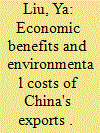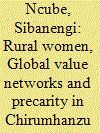| Srl | Item |
| 1 |
ID:
160863


|
|
|
|
|
| Summary/Abstract |
This paper decomposes economic benefits (value‐added) and environmental costs (CO2) of exports according to their sources, and maps the global value network (GVN) and the global emissions network (GEN) for China's exports during 1995–2009 from national, sectoral and national–sectoral perspectives. A comparison is conducted between China and the USA. National GVN and GEN show that shares of value‐added and CO2 emissions from China in its GVN and GEN both decreased first then increased after 2006, while shares from the USA in its GVN and GEN generally decreased. Sectoral GVN and GEN show that among China's exports, “electrical and optical equipment” and “electricity, gas and water supply” were, respectively, the sectors that obtained the most value‐added and emitted the most CO2. National–sectoral GVN and GEN for China exhibited reciprocal and disassortative patterns, and in‐strengths and out‐strengths of GVN and GEN for China's exports were mainly captured by several domestic country–sector pairs.
|
|
|
|
|
|
|
|
|
|
|
|
|
|
|
|
| 2 |
ID:
169331


|
|
|
|
|
| Summary/Abstract |
Governmental investments on the development of high-tech clusters are among the main policies for socioeconomic development, enabling countries to be part of global value networks. Our objective is to identify which are the strategies of countries that want to join global aerospace value networks, by means of an abductive case research. Countries were divided in 3 groups (A; B; C) according to their global aerospace exports share. The analytical framework used to identify the strategies has 3 dimensions: network structure, network governance, and network dynamics. Results show different strategies according to the country's global exports share. While for countries in group A (exports above 1%), a strategy focused on the dimension network structure indicated a sustained high-tech sector. Countries in group C tend to focus on specialization, taking advantage of shifts in technological paradigms to upgrade their development level. The dimension network governance is mainly related to governmental efforts toward the creation of clusters and associations, promoting specialization and collaborative work. Finally, the dimension network dynamics describes the attraction of foreign companies to qualify the clusters at countries who belong to group C, while countries at group A reinforce their research and development activities. The comparison between countries is helpful for governmental representatives who want to develop strategies toward increasing participation in an industrial global value network and for supply chain managers to help selecting the locations for their operations.
|
|
|
|
|
|
|
|
|
|
|
|
|
|
|
|
| 3 |
ID:
178391


|
|
|
|
|
| Summary/Abstract |
In 1991 Zimbabwe liberalised its economy. This resulted in the opening of the national economy to foreign investment. In line with this, subcontracting arrangements between international corporations and local commodity producers became prevalent. While this attracted scholarly interest, most of it is on global agricultural value networks. By tracing the integration of rural women knitters into international markets, this article offers a different case study. While integration into the knitwear global value chain afforded the women an opportunity to earn an income, their employment remained precarious. This article draws on archival data and interviews from participants to make its case.
|
|
|
|
|
|
|
|
|
|
|
|
|
|
|
|